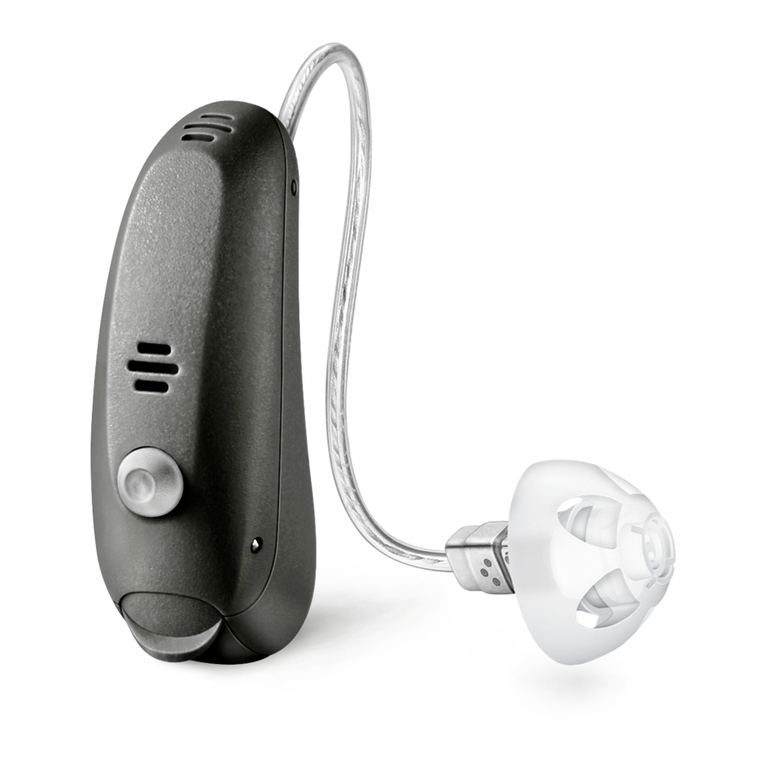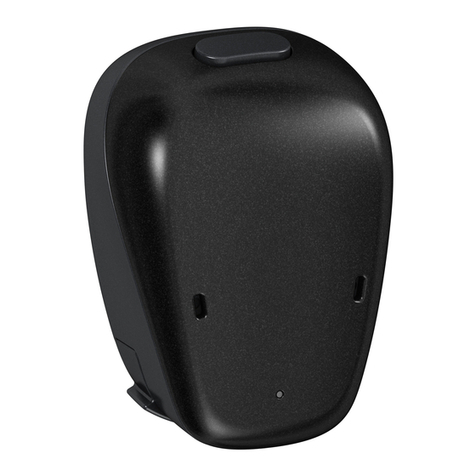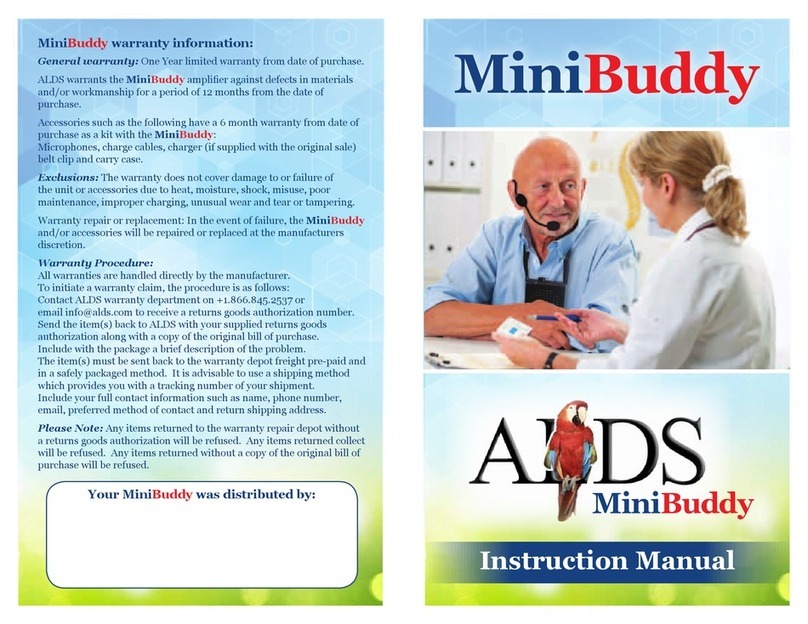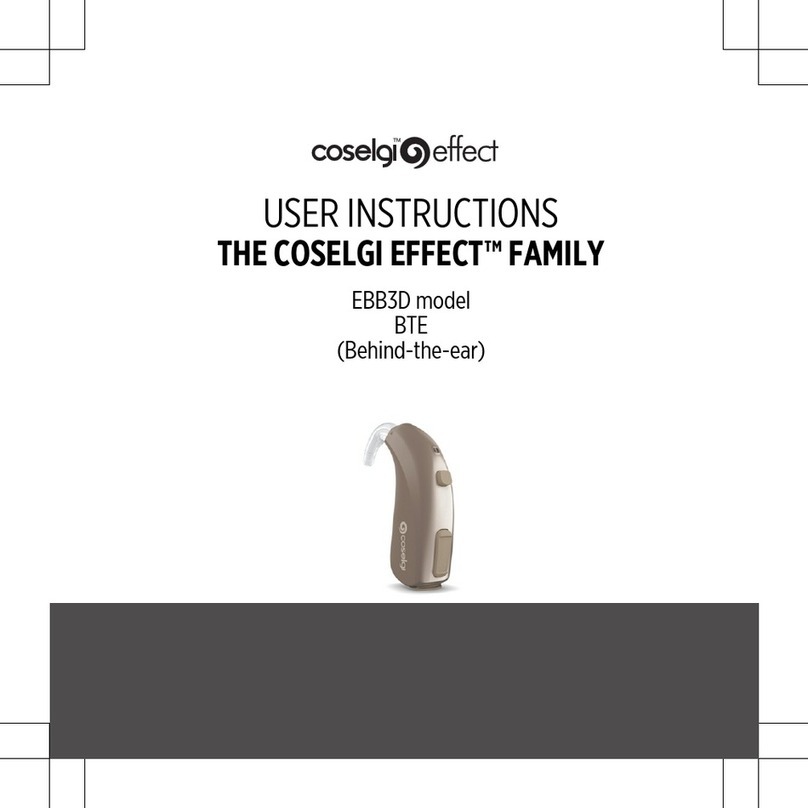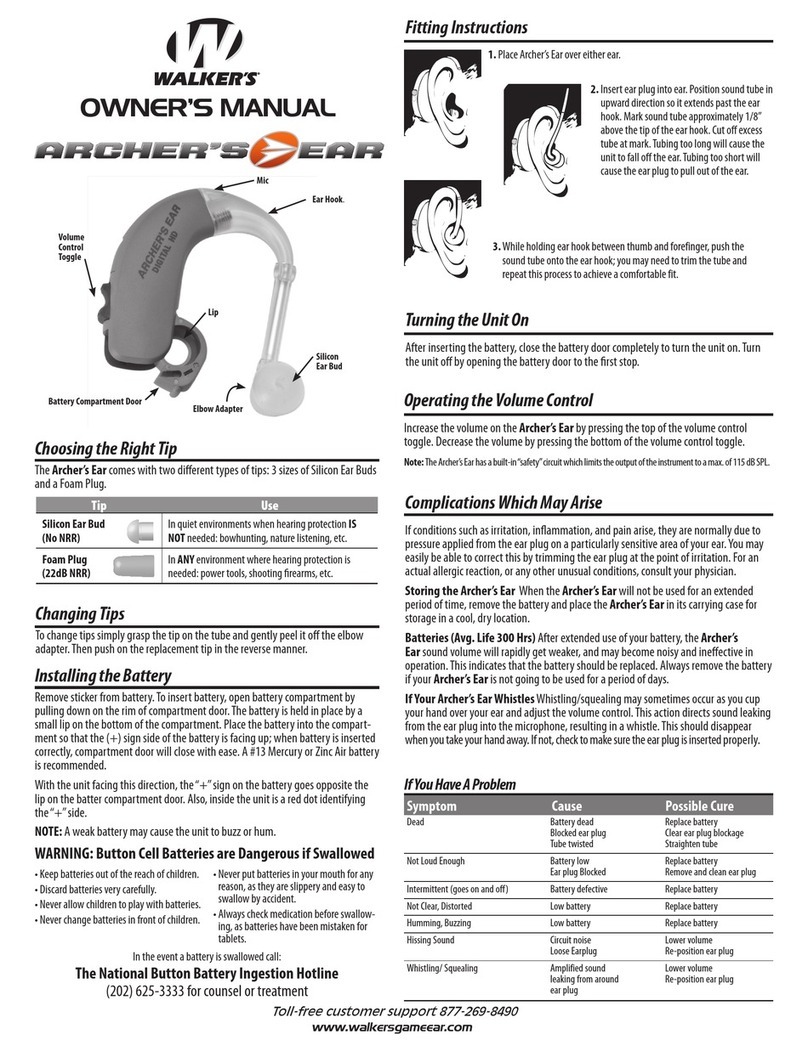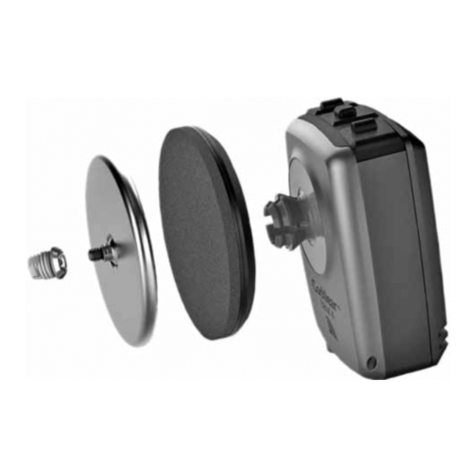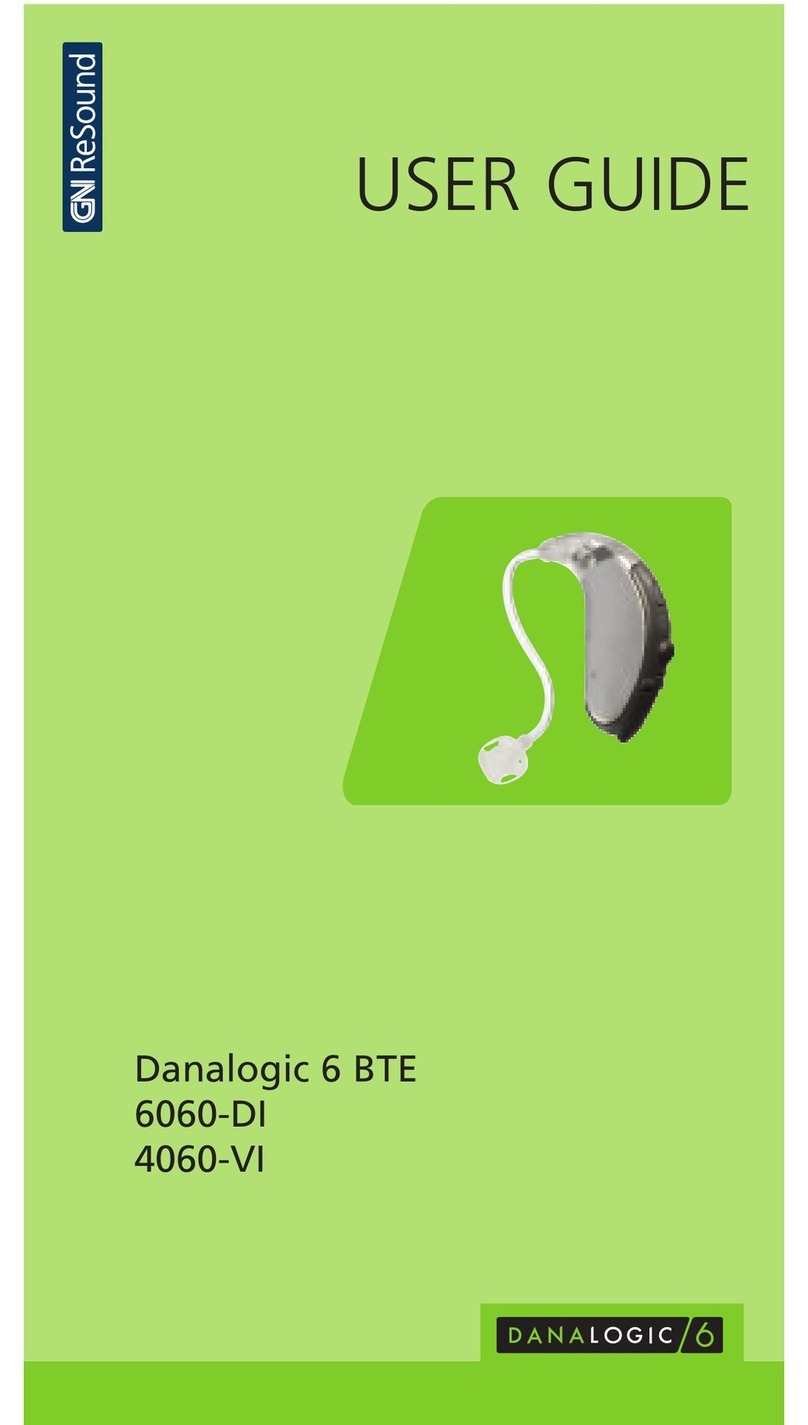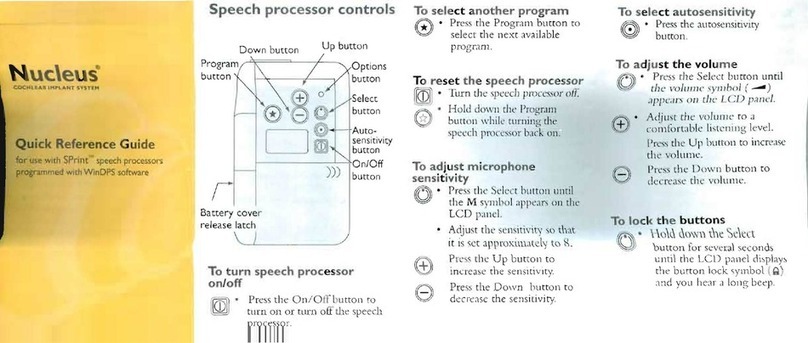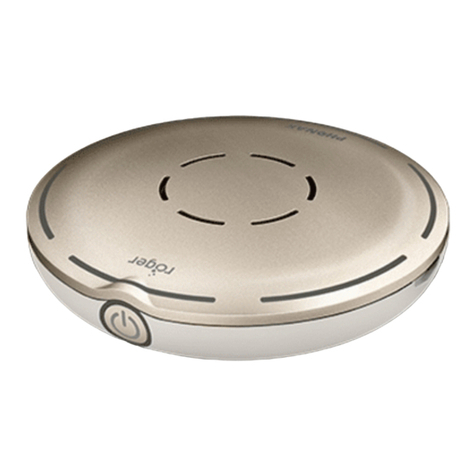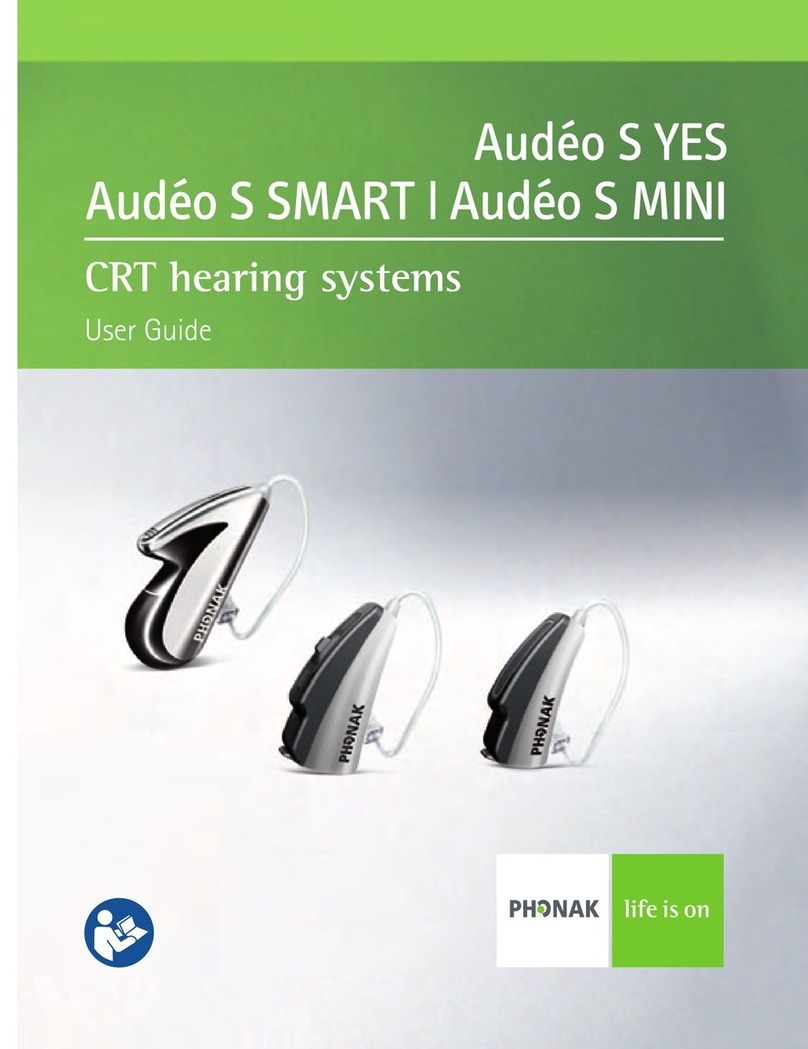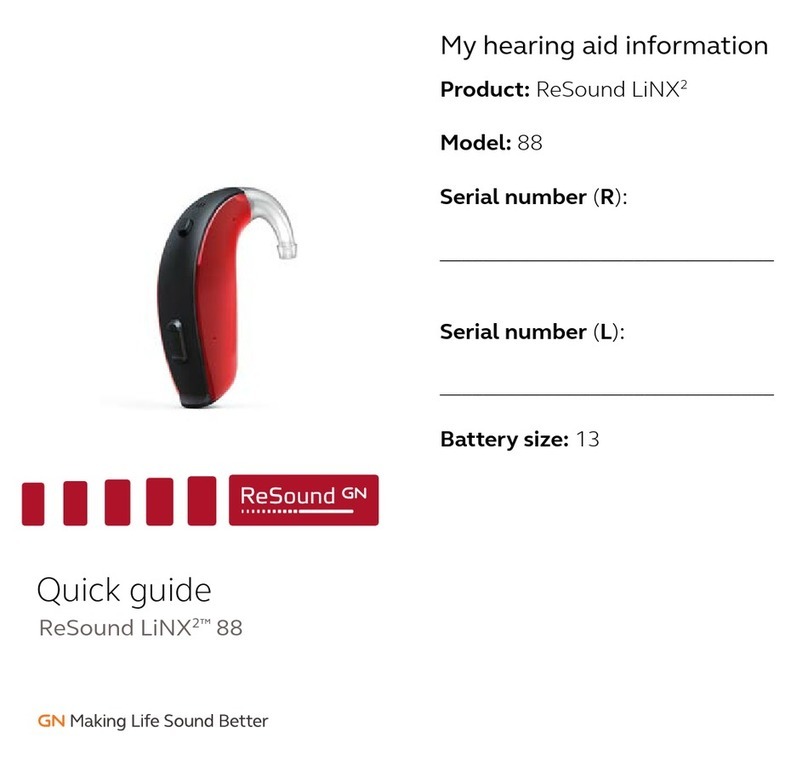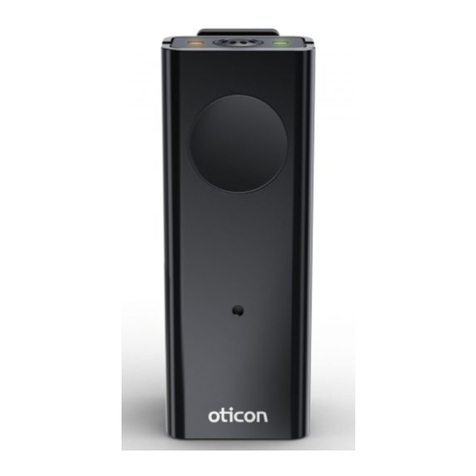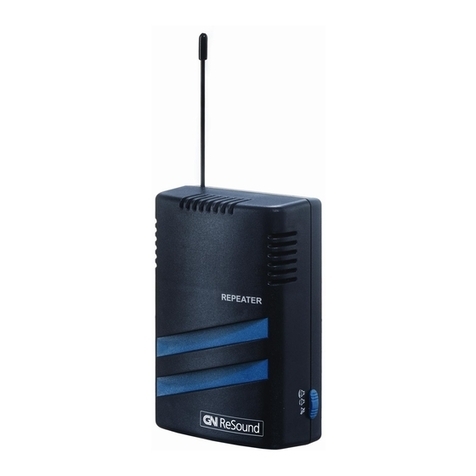Audio Service Mood G5 User manual

USER MANUAL
RIC – HEARING SYSTEMS
MOOD G5
SUN G5

2 3
CONTENT
Welcome 4
Your hearing instruments 5
Instrument type 5
Getting to know your hearing instruments 6
Components and names 7
Controls 10
Hearing programs 11
Features 12
Batteries 13
Battery size and handling tips 13
Replacing batteries 13
Daily use 15
Turning on and o 15
Inserting and removing the hearing instruments 16
Adjusting the volume 20
Changing the hearing program 21
Further adjustments (optional) 21
Special listening situations 22
On the phone 22
Audio streaming with iPhone, iPad or iPod touch 23
Airplane mode 23
Audio induction loops (optional) 24
Maintenance and care 26
Hearing instruments 26
Ear pieces 27
Professional maintenance 29
Further information 30
Safety information 30
Accessories 30
Symbols used in this document 30
Troubleshooting 31
Service and warranty 33

4 5
WELCOME
Thank you for choosing our hearing instruments to
accompany you through everyday life. Like anything new, it
may take you a little time to become familiar with them.
This guide, along with support from your Hearing Care
Professional, will help you understand the advantages and
greater quality of life your hearing instruments oer.
To receive the most benet from your hearing instruments, it
is recommended that you wear them every day, all day. This
will help you get adjusted to them.
CAUTION
It is important to read this user guide and the safety
manual thoroughly and completely. Follow the safety
information to avoid damage or injury.
YOUR HEARING INSTRUMENTS
This user guide describes optional features that your
hearing instruments may or may not have.
Ask your Hearing Care Professional to indicate the
features that are valid for your hearing instruments.
INSTRUMENT TYPE
Your hearing instruments are a RIC (Receiver-in-Canal) model.
The receiver is placed within the ear canal and connected to
the instrument via a receiver cable. The instruments are not
intended for children under the age of 3 years or persons
with a developmental age of under 3 years.
The wireless functionality enables advanced audiological
features and synchronization between your two hearing
instruments.
Your hearing instruments feature Bluetooth® low energy*
technology allowing for easy data exchange with your
smartphone, and for seamless audio streaming with your
iPhone, iPad or iPod touch**.
* The Bluetooth word mark and logos are owned by the Bluetooth SIG, Inc., and any use of
such marks by the legal manufacturer of this product is under licenses. Other trademarks
and trade names are those of their respective owners.
**iPhone, iPad and iPod touch are trademarks of Apple Inc., registered in the U.S. and other
countries.

6 7
GETTING TO KNOW YOUR HEARING INSTRUMENTS
It is recommended to familiarize yourself with your new
hearing instruments. With the instruments in your hand try
using the controls and note their location on the instrument.
This will make it easier for you to feel and press the controls
while wearing the hearing instruments.
If you have problems pressing the controls of your
hearing instruments while wearing them, you can use
a remote control to control your instruments. With
a dedicated smartphone app you have even more
control options.
COMPONENTS AND NAMES
This user guide describes several types of hearing
instruments. Use the following pictures to identify the type of
hearing instrument that you use.
MOOD G5
➐
➏
➊➋
➍
➎
➌
➊Ear piece
➋Receiver
➌Receiver cable
➍Microphone openings
➎Rocker switch (control)
➏Battery compartment
(on/o switch)
➐Side indicator
(red = right ear,
blue = left ear) and
receiver connection

8 9
SUN G5
➐
➑
➏
➊ ➋
➍
➎
➌
➊Ear piece
➋Receiver
➌Receiver cable
➍Microphone openings
➎Rocker switch (control)
➏Battery compartment
(on/o switch)
➐Side indicator
(red = right ear,
blue = left ear)
➑Receiver connection
You can use the following standard ear pieces:
Standard ear pieces Size
Click Dome, Open or Closed
Click Dome Semi-open
Click Dome Double
Click Sleeve, Open or Closed
You can easily exchange the standard ear pieces. Read more
in section “Maintenance and care”.
Custom-made ear pieces
CLIC MOULD

10 11
CONTROLS
With the rocker switch you can, for example,
adjust the volume or switch hearing
programs. Your Hearing Care Professional has
programmed your desired functions to the
rocker switch.
Rocker switch function L R
Press briey:
Program up/down
Volume up/down
Tinnitus therapy signal level up/down
TV stream on/o
Press for about 2 seconds:
Program up/down
Volume up/down
Tinnitus therapy signal level up/down
TV stream on/o
Press for more than 3 seconds:
Standby/turn on
Activate/deactivate airplane mode
L = Left, R = Right
You can also use a remote control to change hearing
programs and adjust the volume of your hearing
instruments. With our smartphone app you have even
more control options.
HEARING PROGRAMS
1
2
3
4
5
6
Read more in section “Changing the hearing program”.

12 13
BATTERIES
When the battery is low the sound becomes weaker or you
will hear an alert signal. The battery type will determine how
long you have to replace the battery.
BATTERY SIZE AND HANDLING TIPS
Ask your Hearing Care Professional for recommended
batteries.
Battery size: 312 13
Always use the correct battery size for your hearing
instruments.
Remove the batteries if you intend not to use the hearing
instruments for several days.
Always carry spare batteries.
Remove empty batteries immediately and follow your
local recycling rules for battery disposal.
REPLACING BATTERIES
Removing the battery:
Open the battery compartment.
FEATURES
Power-on delay enables whistle-free insertion of
hearing instruments.
Read more in section “Turning on and o”.
The tinnitus therapy feature generates a sound to
distract you from your tinnitus.
A telecoil is integrated in the battery compartment,
enabling the hearing instrument to connect with
audio induction loops.
Read more in section “Audio induction loops”.

14 15
Use the magnet stick to pull out the
battery. The magnet stick is available as
an accessory.
Inserting the battery:
If the battery has a protective lm, remove it
only when you are ready to use the battery.
Insert the battery with the “+”symbol
facing up (refer to the picture).
Carefully close the battery compartment. If you feel
resistance, the battery is not inserted correctly.
Do not attempt to close the battery compartment by
force. It can be damaged.
DAILY USE
TURNING ON AND OFF
You have the following options to turn your hearing
instruments on or o.
Via battery compartment:
Turning on: Close the battery compartment.
The default volume and hearing program are set.
Turning o: Open the battery compartment to the rst
catch.
Via rocker switch:
Turning on or o: Press and hold the rocker switch for
several seconds. Refer to section “Controls”for the settings
of the rocker switch.
After turning on, the previously used volume and hearing
program remain set.
When wearing the hearing instruments, an alert tone can
indicate when an instrument is being turned on or o.
When the power-on delay is activated, the hearing
instruments turn on after a delay of several seconds. During
this time you can insert the hearing instruments into your
ears without experiencing unpleasant feedback whistling.
The “power-on delay” can be activated by your Hearing Care
Professional.

16 17
INSERTING AND REMOVING THE HEARING INSTRUMENTS
Your hearing instruments have been ne-tuned for your right
and left ear. Colored markers indicate the
side:
red marker = right ear
blue marker = left ear
Inserting a hearing instrument:
For Click Sleeves, take care that the bend of the
Click Sleeve is in line with the bend of the receiver cable.
Correct:
Incorrect:
Hold the receiver cable at the bend closer to the ear piece.
Carefully push the ear piece in
the ear canal ➊.
Twist it slightly until it sits well.
Open and close your mouth to
avoid accumulation of air in the
ear canal.
Lift the hearing instrument and slide it over the top of
your ear ➋.
CAUTION
Risk of injury!
Insert the ear piece carefully and not too deeply
into the ear.
It may be helpful to insert the right hearing
instrument with the right hand and the left hearing
instrument with the left hand.
If you have problems inserting the ear piece,
use the other hand to gently pull your earlobe
downwards. This opens the ear canal and eases
insertion of the ear piece.

18 19
The optional retention strand helps to securely retain the ear
piece in your ear. To position the retention strand:
Bend the retention strand and position
it carefully into the bottom of the bowl
of your ear (refer to the picture).
Removing a hearing instrument:
Lift the hearing instrument
and slide it over the top of your
ear ➊.
If your hearing instrument is
equipped with a custom shell
or a CLIC MOULD, remove it by
pulling the small removal cord
toward the back of your head.
For all other ear pieces: Grip the receiver in the ear canal
with two ngers and pull it carefully out ➋.
Do not pull the receiver cable.
CAUTION
Risk of injury!
In very rare cases the ear piece could remain in your
ear when removing the hearing instrument. If this
happens, have the ear piece removed by a medical
professional.
Clean and dry your hearing instruments after usage. Read
more in section “Maintenance and care”.

20 21
ADJUSTING THE VOLUME
Your hearing instruments automatically adjust the volume to
the listening situation.
If you prefer manual volume adjustment, press the rocker
switch.
Refer to section “Controls” for the setting of the rocker
switch.
An optional signal tone can indicate the volume change.
Once the maximum or minimum volume has been reached,
you may hear an optional signal tone.
CHANGING THE HEARING PROGRAM
Depending on the listening situation, your hearing
instruments automatically adjust their sound.
Your hearing instruments may also have several hearing
programs which allow you to change the sound, if needed.
An optional signal tone can indicate the program change.
To change the hearing program, press the rocker switch.
Refer to section “Controls” for the setting of the rocker
switch. Refer to section “Hearing programs”for a list of
your hearing programs.
The default volume is applied.
FURTHER ADJUSTMENTS OPTIONAL
You can also use the hearing instrument controls to change
other features, for example, the level of the tinnitus therapy
signal.
Refer to section “Controls” for the setting of your controls.

22 23
SPECIAL LISTENING SITUATIONS
ON THE PHONE
When you are on the phone, hold
the telephone receiver slightly above
your ear. The hearing instrument and
telephone receiver have to be aligned.
Turn the receiver slightly so that the ear is
not completely covered.
TELEPHONE PROGRAM
You may prefer a certain volume when using the phone.
Ask your Hearing Care Professional to congure a telephone
program.
Switch to the telephone program whenever you are on
the phone.
If a telephone program is congured for your hearing
instruments, it is listed in section “Hearing programs”.
AUDIO STREAMING WITH iPHONE, iPAD OR
iPOD TOUCH
Your hearing instruments are Made for iPhone | iPad | iPod
hearing instruments. This means you can get phone calls and
listen to music from your iPhone, iPad or iPod touch directly
into your hearing instruments.
For more information about compatible iOS devices, pairing,
audio streaming and other useful functions, contact your
Hearing Care Professional.
AIRPLANE MODE
In areas where the use of Bluetooth® technology is not
allowed (e.g. on some airplanes), you can activate the
airplane mode. This turns Bluetooth® in your hearing
instruments o temporarily. The hearing instruments still
work without Bluetooth®, however direct audio streaming will
not be possible and other functions will not be available.
To activate or deactivate the airplane mode, use the
controls of your hearing instruments.
Refer to section “Controls” for more information.
An alert tone indicates when airplane mode is activated or
deactivated.

24 25
AUDIO INDUCTION LOOPS OPTIONAL
Some telephones and public places like theatres oer the
audio signal (music and speech) via an audio induction loop.
With this system, your hearing instruments can directly
receive the desired signal – without distracting noise in the
environment.
You can usually recognize audio induction loop
systems by certain signs.
If you want to use this system, a special battery compartment
is required. It is available as an accessory only for certain
types of instruments. Consult your Hearing Care Professional
for more information.
Whenever you are in a place with an audio induction loop:
Switch to the telecoil program.
If a telecoil program is congured for your hearing
instruments, it is listed in section “Hearing programs”.
TELECOIL PROGRAM AND REMOTE CONTROL
NOTICE
For instruments with wireless connectivity:
When the telecoil program is active, the remote control
may cause a pulsing noise.
Use the remote control with a distance greater than
10 cm (4 inches).

26 27
MAINTENANCE AND CARE
To prevent damage it is important that you take care of your
hearing instruments and follow a few basic rules, which will
soon become a part of your daily routine.
HEARING INSTRUMENTS
DRYING AND STORAGE
Dry your hearing instruments overnight.
For longer periods of non-use, store your hearing
instruments in a dry environment with an open battery
compartment and the batteries removed.
Ask your Hearing Care Professional for more information.
CLEANING
Your hearing instruments have a protective coating.
However, if not cleaned regularly you may damage the
hearing instruments or cause personal injury.
Clean your hearing instruments daily with a soft, dry
tissue.
Never use running water or immerse the
devices in water.
Never apply pressure while cleaning.
Ask your Hearing Care Professional for recommended
cleaning products, special care sets, or more information on
how to keep your hearing instruments in good condition.
EAR PIECES
CLEANING
Cerumen (ear wax) may accumulate on the ear pieces. This
may aect sound quality. Clean the ear pieces daily.
For all types of ear pieces:
Clean the ear piece right
after removal with a soft
and dry tissue.
This prevents that
cerumen becomes
dry and hard.
For Click Domes or Click Sleeves:
Squeeze the tip of the ear piece.

28 29
EXCHANGING
Exchange standard ear pieces approximately every three
months. Replace them sooner if you notice cracks or other
changes. The procedure for exchanging standard ear pieces
depends on the type of ear piece. In section “Components
and names”, your Hearing Care Professional has marked your
type of ear piece.
EXCHANGING CLICK DOMES
To remove the old Click Dome, use the removal tool
or follow the instructions on the packaging of the
Click Domes. Be careful not to pull the receiver cable.
The removal tool is available as an accessory.
Take particular care that
the new Click Dome clicks
noticeable in place.
Check the rm t of the new
Click Dome.
clic
k
EXCHANGING CLICK SLEEVES
Turn the Click Sleeve inside
out.
Grasp the Click Sleeve and
the receiver (not the receiver
cable) with your ngers and
pull the Click Sleeve o.
Take particular care that
the new Click Sleeve clicks
noticeably in place.
click
PROFESSIONAL MAINTENANCE
Your Hearing Care Professional can perform a thorough
professional cleaning and maintenance.
Custom-made ear pieces and wax lters should be
exchanged as needed by your Hearing Care Professional.
Ask your Hearing Care Professional for your individual
recommendation of maintenance intervals and for support.

30 31
FURTHER INFORMATION
SAFETY INFORMATION
For more safety information, refer to the safety manual
supplied with the device.
ACCESSORIES
You can use the Smartphone App for convenient remote
control of your hearing instruments. The app also allows you
to deactivate signal tones, to create individual sound proles
and many more functions.
You can also use a remote control.
Consult your Hearing Care Professional for further
information.
SYMBOLS USED IN THIS DOCUMENT
Points out a situation that could lead to serious,
moderate, or minor injuries.
Indicates possible property damage.
Advice and tips on how to handle your device better.
“Made for iPhone”,“Made for iPad”
and “Made for iPod”means that an electronic accessory has
been designed to connect specically to iPhone, iPad or
iPod touch and has been certied by the developer to meet
Apple performance standards. Apple is not responsible for
the operation of this device or its compliance with safety
and regulatory standards. Please note that the use of this
accessory with iPhone, iPad or iPod touch may aect wireless
performance.
TROUBLESHOOTING
Problem and possible solutions
Sound is weak.
Increase the volume.
Replace the battery.
Clean or exchange the ear piece.
Hearing instrument emits whistling sounds.
Reinsert the ear piece until it ts securely.
Decrease the volume.
Clean or exchange the ear piece.
Sound is distorted.
Decrease the volume.
Replace the battery.
Clean or exchange the ear piece.
Hearing instrument emits signal tones.
Replace the battery.

32 33
Problem and possible solutions
Hearing instrument does not work.
Turn the hearing instrument on.
Gently close the battery compartment completely.
Replace the battery.
Make sure the battery is inserted correctly.
Power-on delay is active. Wait several seconds and
check again.
Consult your Hearing Care Professional if you encounter
further problems.
SERVICE AND WARRANTY
Serial numbers Instrument Receiver unit
Left:
Right:
Service dates
1: 4:
2: 5:
3: 6:
Warranty
Date of purchase:
Warranty period in months:
Your Hearing Care Professional


Legal manufacturer:
AS AUDIO-SERVICE GmbH
Alter Postweg 190 · 32584 Löhne · Germany
www.audioservice.com
Art. No. 109 57 149 | V2 | 09.2019 | Subject to technical modifications. Errors excepted.
© 09.2019, AS AUDIO-SERVICE GmbH.
All rights reserved.
This manual suits for next models
1
Table of contents
Other Audio Service Hearing Aid manuals

Audio Service
Audio Service SUN G3 User manual
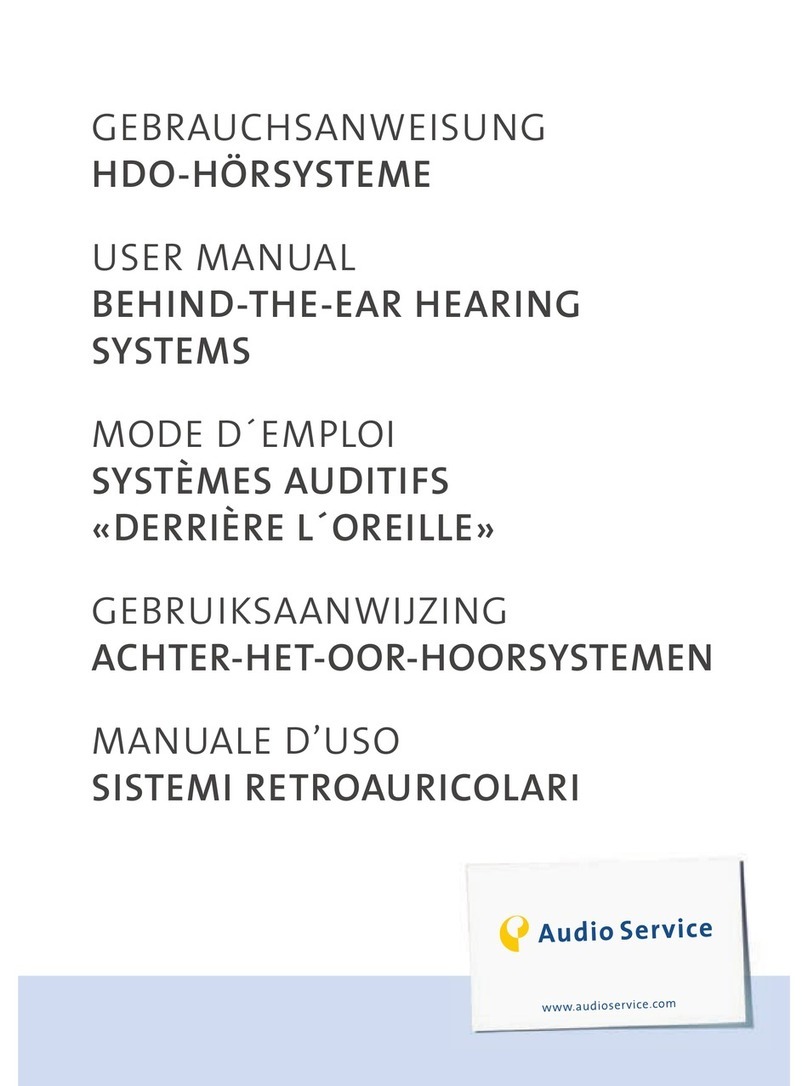
Audio Service
Audio Service NOVA 2 + ASTRAL User manual
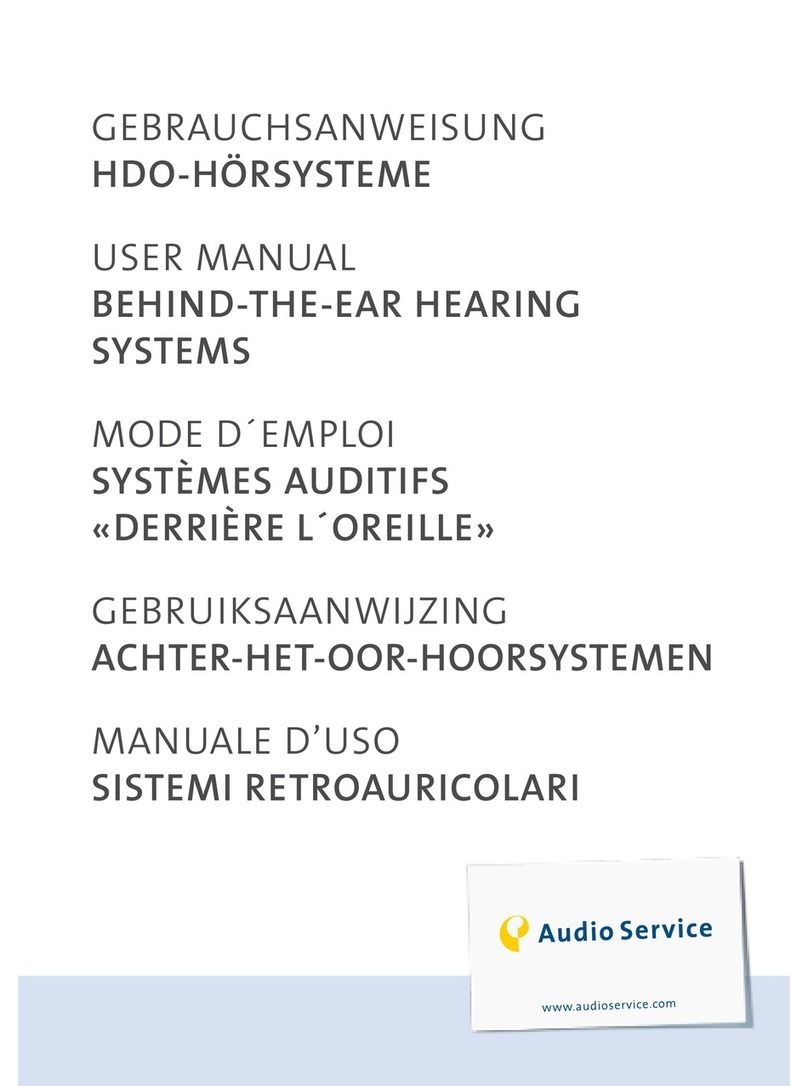
Audio Service
Audio Service XS User manual

Audio Service
Audio Service P Li-Ion G6 User manual
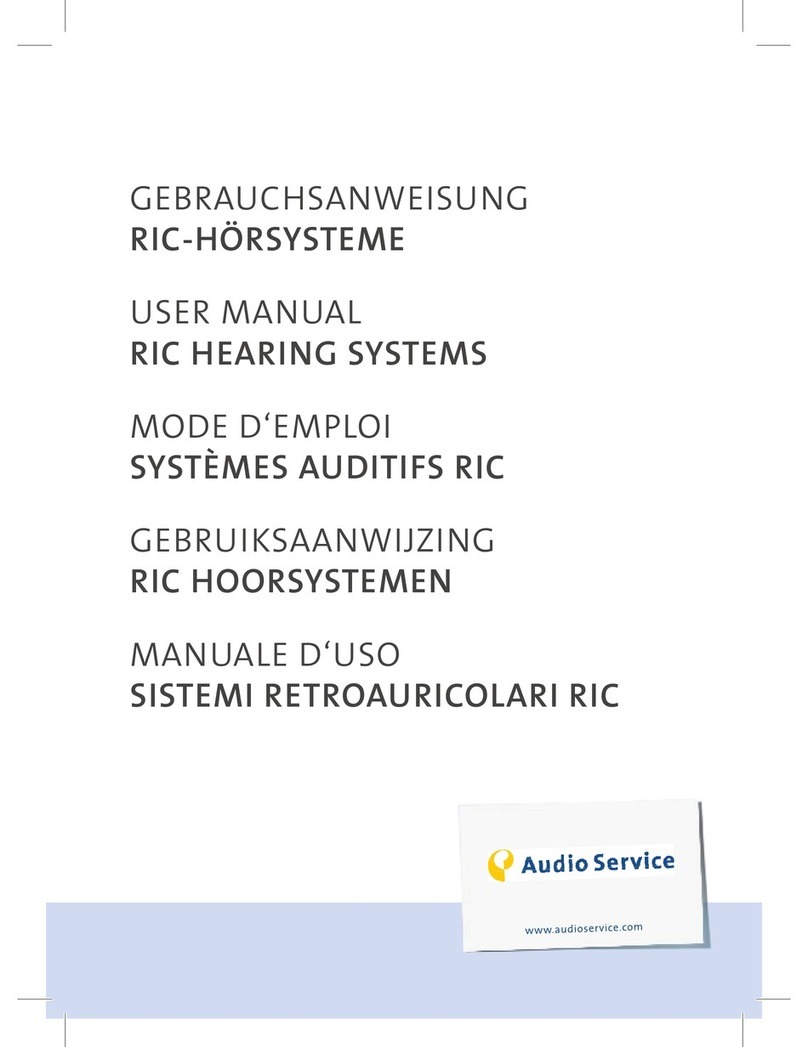
Audio Service
Audio Service RIC RIXX G2 User manual
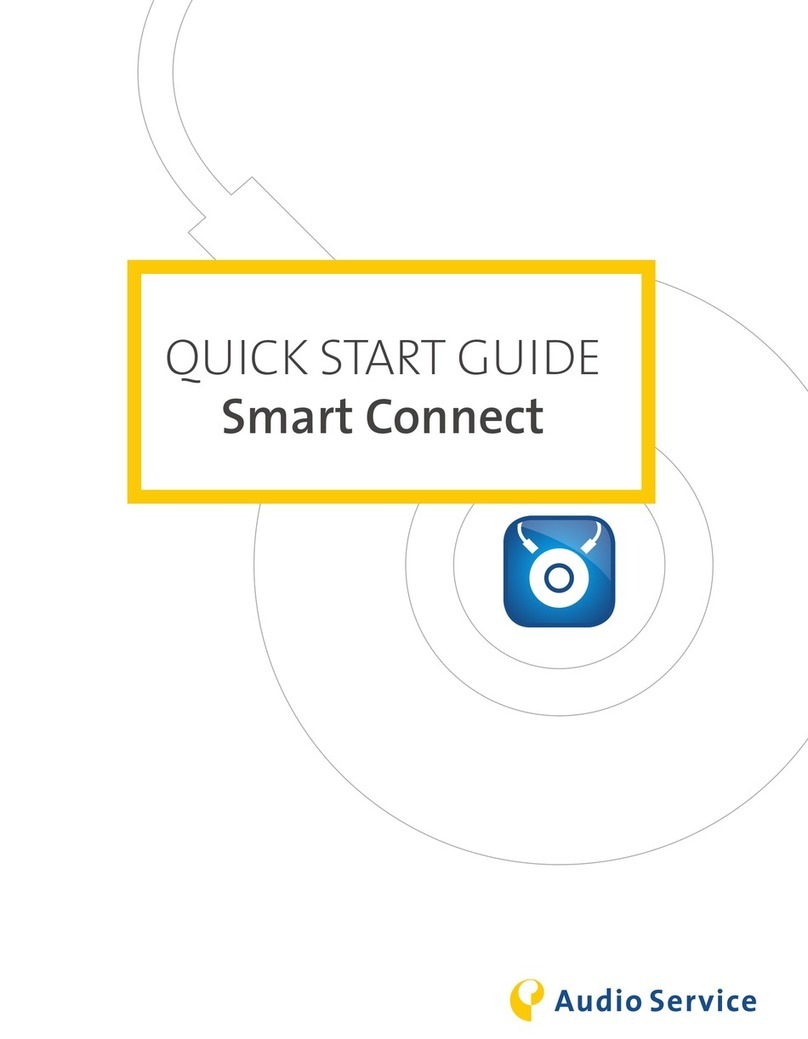
Audio Service
Audio Service Smart Connect User manual
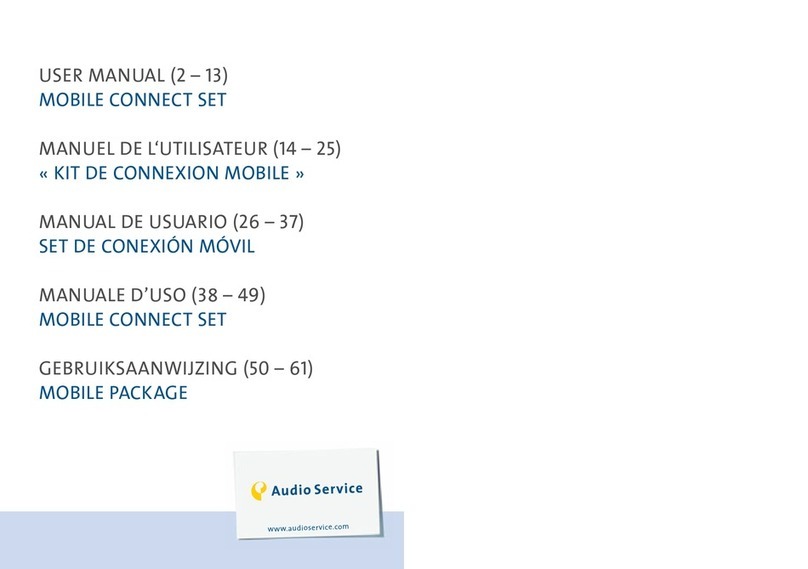
Audio Service
Audio Service Mobile Connect Set User manual
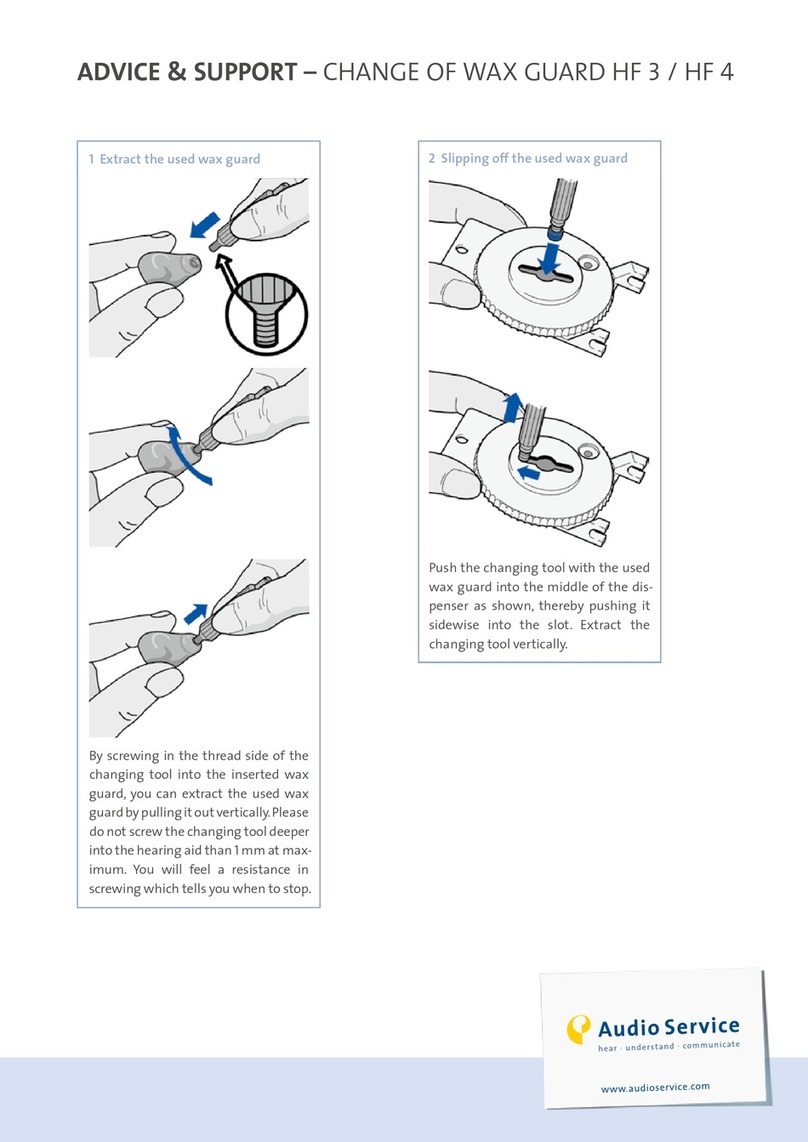
Audio Service
Audio Service HF 3 User manual
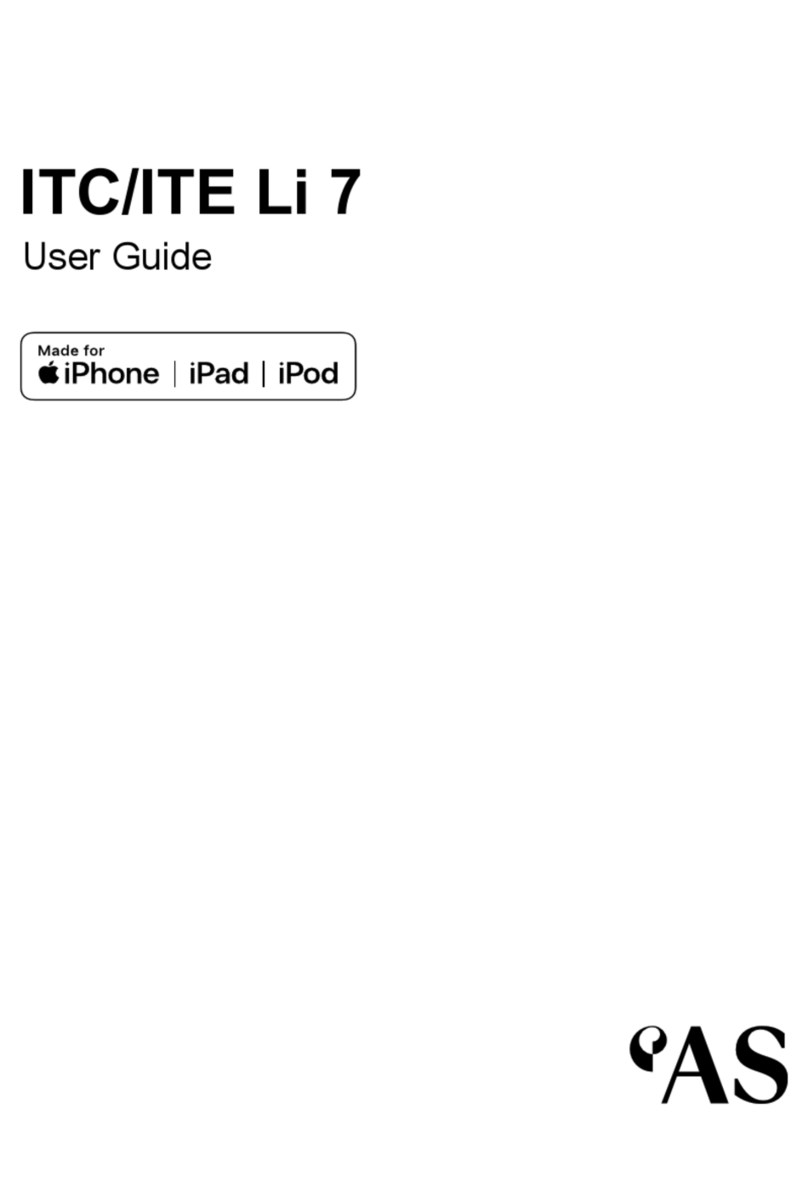
Audio Service
Audio Service ITC Li 7 User manual
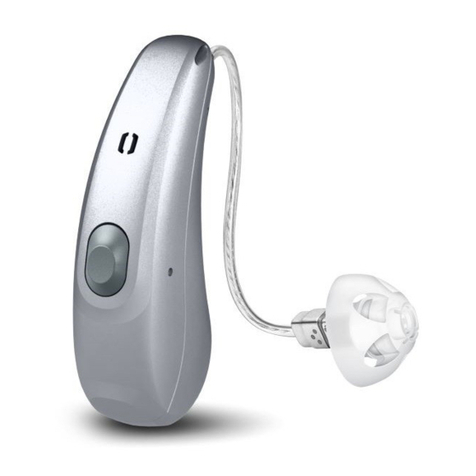
Audio Service
Audio Service MOOD LI-ION G5 User manual
